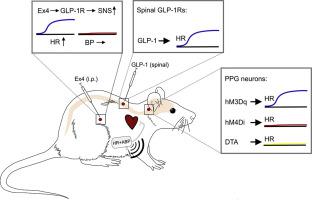Molecular Metabolism ( IF 8.1 ) Pub Date : 2020-05-21 , DOI: 10.1016/j.molmet.2020.101024 Marie K Holt 1 , Daniel R Cook 1 , Daniel I Brierley 1 , James E Richards 1 , Frank Reimann 2 , Alexander V Gourine 1 , Nephtali Marina 1 , Stefan Trapp 1

|
Objective
Glucagon-like peptide-1 receptor agonists (GLP-1RAs) are used as anti-diabetic drugs and are approved for obesity treatment. However, GLP-1RAs also affect heart rate (HR) and arterial blood pressure (ABP) in rodents and humans. Although the activation of GLP-1 receptors (GLP-1R) is known to increase HR, the circuits recruited are unclear, and in particular, it is unknown whether GLP-1RAs activate preproglucagon (PPG) neurons, the brain source of GLP-1, to elicit these effects.
Methods
We investigated the effect of GLP-1RAs on heart rate in anaesthetized adult mice. In a separate study, we manipulated the activity of nucleus tractus solitarius (NTS) PPG neurons (PPGNTS) in awake, freely behaving transgenic Glu-Cre mice implanted with biotelemetry probes and injected with AAV-DIO-hM3Dq:mCherry or AAV-mCherry-FLEX-DTA.
Results
Systemic administration of the GLP-1RA Ex-4 increased resting HR in anaesthetized or conscious mice, but had no effect on ABP in conscious mice. This effect was abolished by β-adrenoceptor blockade with atenolol, but unaffected by the muscarinic antagonist atropine. Furthermore, Ex-4-induced tachycardia persisted when PPGNTS neurons were ablated, and Ex-4 did not induce expression of the neuronal activity marker cFos in PPGNTS neurons. PPGNTS ablation or acute chemogenetic inhibition of these neurons via hM4Di receptors had no effect on resting HR. In contrast, chemogenetic activation of PPGNTS neurons increased resting HR. Furthermore, the application of GLP-1 within the subarachnoid space of the middle thoracic spinal cord, a major projection target of PPG neurons, increased HR.
Conclusions
These results demonstrate that both systemic application of Ex-4 or GLP-1 and chemogenetic activation of PPGNTS neurons increases HR. Ex-4 increases the activity of cardiac sympathetic preganglionic neurons of the spinal cord without recruitment of PPGNTS neurons, and thus likely recapitulates the physiological effects of PPG neuron activation. These neurons therefore do not play a significant role in controlling resting HR and ABP but are capable of inducing tachycardia and so are likely involved in cardiovascular responses to acute stress.
中文翻译:

孤束核中的 PPG 神经元调节心率,但不介导 GLP-1 受体激动剂诱导的小鼠心动过速。
客观的
胰高血糖素样肽-1 受体激动剂 (GLP-1RA) 被用作抗糖尿病药物,并被批准用于肥胖症治疗。然而,GLP-1RAs 也会影响啮齿动物和人类的心率 (HR) 和动脉血压 (ABP)。虽然已知 GLP-1 受体 (GLP-1R) 的激活会增加 HR,但募集的电路尚不清楚,特别是 GLP-1RA 是否激活前胰高血糖素 (PPG) 神经元(GLP-1 的脑源)尚不清楚, 以引发这些影响。
方法
我们研究了 GLP-1RAs 对麻醉成年小鼠心率的影响。在另一项研究中,我们在清醒时操纵孤束核 (NTS) PPG 神经元 (PPG NTS ) 的活动,自由行为的转基因 Glu-Cre 小鼠植入生物遥测探针并注射 AAV-DIO-hM3Dq:mCherry 或 AAV-mCherry -FLEX-DTA。
结果
GLP-1RA Ex-4 的全身给药增加了麻醉或清醒小鼠的静息心率,但对清醒小鼠的 ABP 没有影响。用阿替洛尔阻断 β-肾上腺素能受体可消除这种作用,但不受毒蕈碱拮抗剂阿托品的影响。此外,当 PPG NTS神经元被消融时,Ex-4 诱导的心动过速持续存在,并且 Ex-4 不诱导 PPG NTS神经元中神经元活动标记 cFos 的表达。通过 hM4Di 受体对这些神经元的PPG NTS消融或急性化学遗传学抑制对静息 HR 没有影响。相反,PPG NTS的化学遗传学激活神经元增加静息心率。此外,GLP-1 在中胸脊髓蛛网膜下腔(PPG 神经元的主要投射目标)内的应用增加了 HR。
结论
这些结果表明,Ex-4 或 GLP-1 的全身应用和 PPG NTS神经元的化学遗传学激活都会增加 HR。Ex-4 在不募集 PPG NTS神经元的情况下增加了脊髓心脏交感神经节前神经元的活动,因此可能概括了 PPG 神经元激活的生理效应。因此,这些神经元在控制静息 HR 和 ABP 方面没有发挥重要作用,但能够诱导心动过速,因此可能参与心血管对急性压力的反应。


























 京公网安备 11010802027423号
京公网安备 11010802027423号